#ho quoc pagoda
Explore tagged Tumblr posts
Text

Ho Quoc Pagoda, Phu Quoc, Vietnam: Ho Quoc Pagoda, also known as Truc Lam Ho Quoc, is the largest & most peaceful Buddhist temple on Phu Quoc Island. The temple is situated along the coastal 10-km road in the north of Sao Beach. The panoramic sea view from the temple grounds is unsurpassed & very worth a visit
100 notes
·
View notes
Text
Ho Quoc Temple Vietnam
Ho Quoc Temple Vietnam When we think about a place that evokes a sense of peace and focus, surrounded by nature and mountains, makes me think of a temple. Here we are at Ho Quoc Temple, located on Phu Quoc Island, Vietnam. Behind the temple, there is a large mountain, while in front, you’ll be greeted by breathtaking ocean views. Let’s Talk about Ho Quoc Pagoda Ho Quoc Temple Vietnam: A Serene…

View On WordPress
#buddha statue#buddhism beliefs#buddhist#buddhist traditions#chua ho quoc phu quoc#hiring a driver#ho quoc pagoda#ho quoc temple#monastery#ocean views#phu quoc island vietnam#spiritual meditation#spiritual retreat#temple#tourist spot#traditional vietnamese#vietnamese culture#vietnamese temple#vlog#wooden carvings#zen
0 notes
Text
Day 3: Ethnology and War
The first two days were mere warm-ups. Today the real “program” began. I started the day by meeting Trung (“Tony”) Nguyen who, for the next three days in Hanoi will be my “personal guide, translator, and photographer” (his words, not mine). Tony’s 37 but he barely looks 18. He says I don’t look my age either, but I think he’s just being polite.
Our first visit was to the Tran Quoc pagoda, Hanoi's oldest pagoda, which is located on a small island in West Lake. Unlike Japanese pagodas, which typically have five levels, Vietnamese pagodas can be of any size whatsoever. The Tran Quoc pagoda has eleven levels, each with its own statue of the Buddha.

Next, we headed to the Vietnam Ethnology Museum, which seeks to preserve the culture of all 54 different ethnic groups that are found in Vietnam. The Kinh or Viets are by far the largest group, accounting for roughly 85 percent of the population. But the others all have their own dialects, styles of dress, traditions, and forms of housing. Behind the ethnology museum is a large park where many examples of these houses appear. Some of them are stilt houses, the raised platforms providing protection from floods and, when necessary, wild animals.

After lunch, we went to the complex dedicated to Ho Chi Minh, the nation's founder who’s routinely and affectionately referred to as “Uncle Ho”. The complex includes Ho Chi Minh's Mausoleum, modeled on Lenin’s tomb,

the Presidential Palace,

the small stilt house where Ho actually lived,

and the One Pillar Pagoda, built in 1049 of wood attached to a single stone pillar, creating the shape of a lotus blossom.

The day concluded with a tour of the Vietnam Military History Museum, documenting the almost continuous warfare experienced by the Vietnamese since 179 B.C. when the country was first invaded by China. Many of the individual battles fought against the French and the Americans are presented in lavish detail, with rows of lights indicating troop movements and skirmishes. The outdoor area is filled with tanks, helicopters, airplanes, and various large weapons.

Tired as I was by the end of the day, I climbed the Flag Tower of Hanoi which is also on the museum’s grounds and serves as one of the symbols of the capital city. For example, it appears on the 1985 series of Vietnamese currency, ranging from notes of 5 hao to ten đồng. (The lao is no longer issued, and the currency now in use was first issued in 2003.)

3 notes
·
View notes
Text
Everything You Need to Know About Celebrating Tet in Vietnam
Tet Holiday, the most significant and vibrant celebration in Vietnam, marks the beginning of the Lunar New Year. This cherished festival is deeply rooted in Vietnamese traditions, reflecting the country’s rich cultural heritage, strong family bonds, and hopes for a prosperous year ahead. Overflowing with colorful decorations, lively celebrations, and delicious food, Tet is an unmissable experience for both locals and travelers.
In 2026, Tet will be observed from February 14 to February 22, with the first day of the Lunar New Year falling on February 17. If you’re planning to visit Vietnam during this period, this guide will help you celebrate Tet Holiday like a true Vietnamese, allowing you to experience its joy, warmth, and traditions to the fullest.
1. Preparing for Tet Holiday
Tet preparations begin weeks before the actual holiday, as families embark on a thorough house cleaning to sweep away bad luck and welcome a fresh start. Homes are beautifully decorated with vibrant colors, calligraphy, and traditional ornaments, creating an atmosphere of renewal and joy.
Markets and shopping streets come alive with festive energy, offering everything from new clothes to holiday foods and decorations. Wandering through the bustling streets of Hanoi and Ho Chi Minh City during this time is an unforgettable experience. Traditional markets are a must-visit, where you can purchase unique Tet souvenirs and immerse yourself in the pre-holiday excitement.
Recommended shopping spots for Tet:
Hanoi: Hang Luoc Street, Hang Ma Street, Hang Dao Street, Dong Xuan Market, Hang Be Market
Ho Chi Minh City: Nguyen Hue Walking Street, Ben Thanh Market, Ho Thi Ky Flower Market

A signature Tet decoration is the display of ornamental plants, which symbolize prosperity and good fortune. In Northern Vietnam, people favor kumquat trees and cherry blossoms due to the cool climate, while in the South, bright yellow apricot blossoms are the preferred choice for welcoming the new year.
Photo tip: Even if you can’t take these ornamental plants home, don’t hesitate to ask vendors if you can take some pictures with them—it’s a great way to capture the spirit of Tet!
2. Enjoying Traditional Tet Cuisine
Tet is a time when food plays a central role, bringing families together in joyful feasts and honoring ancestors. Each region has its own specialties that carry deep cultural significance:
Northern Vietnam: Bánh Chưng (Square Sticky Rice Cake), Nem Rán (Fried Spring Rolls), Gà Luộc (Boiled Chicken)
Southern Vietnam: Bánh Tét (Cylindrical Sticky Rice Cake), Thịt Kho Hột Vịt (Caramelized Pork with Eggs), Canh Khổ Qua (Bitter Melon Soup)
While many restaurants serve these dishes, the most authentic way to enjoy them is by joining a local family’s Tet feast. If you have Vietnamese friends, don’t hesitate to accept an invitation to their home.

Another memorable way to celebrate Tet is by participating in the making of Bánh Chưng or Bánh Tét. This traditional dish represents the harmony between heaven and earth and is an essential offering to ancestors. Families gather around to wrap these sticky rice cakes together, fostering a warm and festive environment filled with laughter and bonding.
3. Taking Part in Tet Festivities
Visit Temples and Pagodas

One of the most cherished traditions of Tet is visiting temples and pagodas to pray for health, happiness, and success in the coming year. Many people also take part in calligraphy activities, acquiring meaningful couplets to bring prosperity to their homes. Some visitors seek fortune-telling by drawing random cards or bamboo sticks, adding a touch of mystery and excitement to the experience.
Popular temples to visit:
Hanoi: Temple of Literature, Ngoc Son Temple, Tran Quoc Temple
Ho Chi Minh City: Jade Emperor Temple, Mariamman Temple, Thien Hau Temple
Celebrate New Year’s Eve with Fireworks

Fireworks are a spectacular highlight of Tet, lighting up the night sky to mark the transition into the new year. The best places to enjoy these dazzling displays include:
Hanoi: Hoan Kiem Lake, Ba Dinh Square, Long Bien Bridge
Ho Chi Minh City: Saigon River, April 30 Square, Dam Sen Square
Honor the Kitchen Gods

A week before Tet (on the 23rd of Lunar December), Vietnamese families bid farewell to the Kitchen Gods, known as "Ong Cong, Ong Tao," who return to heaven to report on the household’s affairs. Offerings of sticky rice, fruits, and even goldfish are made as a token of gratitude for their guidance and protection throughout the year.
Participate in Tet Customs

Tet is filled with meaningful traditions that bring good fortune:
Exchange Tet greetings: During the first few days of Tet, families and friends visit one another to share well wishes for the new year. Common greetings include:
“Chúc mừng năm mới” (Happy New Year)
“An khang thịnh vượng” (Peace and Prosperity)
“Vạn sự như ý” (May all things go as you wish)
Give lucky money: Known as "li xi," giving red envelopes containing money is a cherished Tet tradition, symbolizing prosperity and good fortune. It’s best to give even-numbered amounts while avoiding numbers like 4 and 6, which are considered unlucky.
Avoid Tet taboos: To ensure a good start to the year, it’s important to refrain from negative actions like arguing, breaking things, or giving someone fire, as these are believed to bring bad luck.
4. Tips for Travelers Visiting Vietnam During Tet
Tet is a busy travel period, as many locals return to their hometowns, leading to increased traffic and fully booked accommodations. To ensure a smooth trip, travelers should:
Book flights, trains, and hotels well in advance
Be aware that some attractions and restaurants may close during Tet
Plan ahead by researching opening hours and having backup food options
5. Weather Conditions in Vietnam During Tet
The climate varies across different regions of Vietnam during Tet:
Northern Vietnam: Hanoi experiences cool temperatures (15°C–20°C), while mountainous areas like Sapa and Ha Giang can drop to around 10°C. Pack a jacket for chilly evenings.
Central Vietnam: Da Nang and Hoi An enjoy mild weather (20°C–25°C), making sightseeing and outdoor activities comfortable.
Southern Vietnam: Ho Chi Minh City and the Mekong Delta are warm and sunny (25°C–30°C), ideal for enjoying outdoor festivities.
Conclusion
Tet is an extraordinary time to experience Vietnam’s rich culture, warm traditions, and festive spirit. From exploring bustling markets and enjoying traditional dishes to participating in age-old customs and temple visits, celebrating Tet like a local is a truly unforgettable experience.
If you’re planning a trip to Vietnam during Tet, Travel Sense Asia can craft a personalized itinerary tailored to your interests. Contact us to make your Tet Holiday in Vietnam a magical and seamless journey!
0 notes
Text
10 Must-Visit Destinations in Vietnam for Every Traveler

Vietnam is a treasure trove of cultural heritage, breathtaking landscapes, and culinary delights. Whether you're an adventurer, history buff, or foodie, Vietnam offers something for everyone. Here are ten must-visit destinations that should top your travel list.
1. Hanoi
The capital city of Vietnam is a harmonious blend of old and new. Wander through the bustling streets of the Old Quarter, visit the historic Ho Chi Minh Mausoleum, and enjoy a traditional water puppet show. Don’t forget to savor authentic Pho and Vietnamese coffee.
2. Halong Bay
A UNESCO World Heritage Site, Halong Bay is famous for its emerald waters and towering limestone karsts. Cruise through the bay, kayak into hidden caves, and spend the night on a luxury boat to fully appreciate its natural beauty.
3. Sapa
Nestled in the northern mountains, Sapa is a paradise for trekkers and nature lovers. Terraced rice fields, vibrant ethnic villages, and misty peaks make this region a dream destination for photographers and adventure enthusiasts alike.
4. Hoi An
Known as the “City of Lanterns,” Hoi An captivates visitors with its well-preserved ancient town, vibrant markets, and charming riverside. Tailor-made clothing, delectable street food, and cycling tours are some highlights you can’t miss.
5. Hue
As the former imperial capital, Hue is rich in history and culture. Explore the majestic Hue Citadel, ancient pagodas, and the iconic Perfume River. Don’t miss the chance to try the city’s unique royal cuisine.
6. Da Nang
With its pristine beaches and modern vibe, Da Nang is a top choice for relaxation. Visit the famous Golden Bridge supported by giant stone hands, explore the Marble Mountains, and enjoy the vibrant nightlife along My Khe Beach.
7. Nha Trang
Famous for its crystal-clear waters and vibrant coral reefs, Nha Trang is a haven for beach lovers and scuba divers. The VinWonders amusement park and mud baths also add to the city's appeal.
8. Ho Chi Minh City (Saigon)
Vietnam's largest city is a bustling metropolis with a mix of colonial charm and modernity. Visit landmarks like the Cu Chi Tunnels, War Remnants Museum, and Notre-Dame Cathedral Basilica. Don’t forget to enjoy the vibrant street food scene.
9. Mekong Delta
Dubbed as Vietnam’s "rice bowl," the Mekong Delta offers a unique experience with its floating markets, lush orchards, and winding waterways. A boat tour through this region will give you a glimpse into the daily life of local communities.
10. Phu Quoc Island
If you're seeking a tropical escape, Phu Quoc is the place to be. With its white-sand beaches, luxury resorts, and crystal-clear waters, this island is ideal for relaxation. Snorkeling, diving, and exploring the lush national park are must-do activities.
Vietnam Tour Packages by DHT Holidays
To make the most of your Vietnamese adventure, DHT Holidays offers comprehensive Vietnam Tour Packages tailored to your needs. Whether you wish to explore the cultural heritage of Hanoi, cruise the stunning Halong Bay, or relax on the pristine beaches of Phu Quoc, we’ve got you covered. Book Vietnam Tour Packages with us to enjoy seamless travel arrangements, experienced guides, and unforgettable experiences. Let us take the hassle out of planning your dream Vietnam vacation!
Contact Details
Phone- 91-9999123443
Email- [email protected]
0 notes
Text
Discover Vietnam with Look Book Fly: Perfect Tour Packages for Your Adventure

Vietnam, a land of vibrant culture, breathtaking landscapes, and rich history, has become a favorite travel destination for globetrotters. Whether you're seeking tranquil beaches, bustling cities, or serene countryside, Vietnam offers an unforgettable experience. At Look Book Fly, we bring you carefully curated Vietnam tour packages that cater to your desires, ensuring an enriching and hassle-free travel experience.
Why Choose Vietnam as Your Next Travel Destination?
Diverse Landscapes Vietnam boasts a stunning variety of landscapes, from the emerald rice terraces of Sapa to the serene waters of Halong Bay and the sandy beaches of Da Nang. These natural wonders provide the perfect backdrop for both relaxation and adventure.
Rich Cultural Heritage Steeped in history, Vietnam offers a unique blend of ancient traditions and modern influences. Cities like Hanoi and Ho Chi Minh City feature historical landmarks such as the Imperial Citadel and Cu Chi Tunnels, alongside vibrant nightlife and contemporary attractions.
Delicious Cuisine Food lovers will revel in Vietnam's renowned cuisine, including dishes like pho, banh mi, and fresh spring rolls. Each region has its own culinary specialties, offering a delectable journey for your taste buds.
Warm Hospitality Vietnamese people are known for their warmth and hospitality, making visitors feel welcome and cared for throughout their stay.
Explore Our Vietnam Tour Packages
At Look Book Fly, we design our Vietnam tour packages to suit every traveler’s needs, whether you’re a solo adventurer, a family, or a honeymoon couple. Here's what you can expect from our packages:
Cultural Highlights Tour
Duration: 7 Days / 6 Nights
Destinations: Hanoi, Hue, Hoi An, Ho Chi Minh City
Inclusions:
Guided city tours
Visits to historical sites such as the War Remnants Museum and Thien Mu Pagoda
Authentic Vietnamese cooking classes
Nature and Adventure Tour
Duration: 8 Days / 7 Nights
Destinations: Halong Bay, Sapa, Ninh Binh
Inclusions:
Halong Bay cruise with kayaking and cave exploration
Trekking through the terraced rice fields of Sapa
Boat rides in the scenic Trang An Grottoes
Beach Getaway Tour
Duration: 6 Days / 5 Nights
Destinations: Da Nang, Nha Trang, Phu Quoc
Inclusions:
Relaxation at luxury beach resorts
Water sports like snorkeling and diving
Island-hopping tours
Customized Tours
Want something unique? Let us design a personalized Vietnam tour package just for you. Whether it’s a food tour in Hanoi, a luxury cruise in Halong Bay, or a family-friendly itinerary, we’ll tailor every detail to meet your preferences.
What Sets Look Book Fly Apart?
Expertly Curated Itineraries Our team of travel experts ensures that every aspect of your Vietnam tour is thoughtfully planned, giving you a seamless experience.
Affordable Prices We offer competitive pricing without compromising on quality. Our packages include accommodations, meals, transportation, and guided tours, providing exceptional value.
Local Insights Our partnerships with local guides and businesses ensure you experience Vietnam authentically, from hidden gems to cultural insights.
Hassle-Free Planning From visa assistance to flight bookings, we handle all the details, so you can focus on enjoying your trip.
Tips for Traveling to Vietnam
Best Time to Visit: The best time to explore Vietnam is from March to April and September to November when the weather is pleasant.
Currency: The local currency is the Vietnamese Dong (VND). Carry cash for local markets and street vendors.
Travel Essentials: Don’t forget to pack comfortable footwear, sunscreen, and travel insurance.
Book Your Vietnam Adventure Today!
At Look Book Fly, we believe that travel should be an enriching and joyful experience. Our Vietnam tour packages are designed to offer you just that, combining comfort, adventure, and cultural exploration. Whether you’re a history buff, a nature enthusiast, or a beach lover, Vietnam has something for everyone.
Let us help you create unforgettable memories in Vietnam. Contact Look Book Fly today to explore our tour packages and start planning your dream vacation!
0 notes
Text
Vietnam Tour Packages: An Overview
Vietnam is a country rich in history, culture, and natural beauty. A tour package to Vietnam can include a variety of experiences, from exploring bustling cities and historical sites to relaxing on pristine beaches and enjoying the stunning landscapes. Here's a guide to some must-visit places, activities, and tips for planning your Vietnam tour package.

Must-Visit Places in Vietnam
Hanoi: The capital city is known for its centuries-old architecture and rich culture. Key attractions include:
Hoan Kiem Lake
Old Quarter
Ho Chi Minh Mausoleum
Temple of Literature
Halong Bay: Famous for its emerald waters and thousands of towering limestone islands topped with rainforests. Activities include:
Boat cruises
Kayaking
Exploring caves
Hoi An: A well-preserved ancient town that is a UNESCO World Heritage Site. Highlights include:
Lantern-lit streets
Japanese Covered Bridge
Tailor shops for custom-made clothing
Riverside markets
Hue: Known for its historic significance and imperial architecture. Must-see spots:
Imperial City
Perfume River
Thien Mu Pagoda
Ho Chi Minh City (Saigon): A bustling metropolis with a mix of modern and historical landmarks. Key places to visit:
War Remnants Museum
Notre-Dame Cathedral Basilica of Saigon
Ben Thanh Market
Cu Chi Tunnels (nearby)
Mekong Delta: Known as the "Rice Bowl" of Vietnam, it's a region of rivers, swamps, and islands. Activities include:
Boat tours
Visiting floating markets
Exploring local villages
Sapa: Famous for its terraced rice fields and ethnic minority communities. Activities:
Trekking
Visiting local villages
Enjoying mountain views
Popular Activities
Cultural Experiences: Participate in traditional festivals, cooking classes, and craft workshops.
Adventure: Go trekking, biking, or take a motorbike tour through the countryside.
Culinary Tours: Explore Vietnam's diverse cuisine with food tours and cooking classes.
Beach Relaxation: Enjoy the beautiful beaches in places like Nha Trang, Phu Quoc, and Da Nang.

Tips for Planning Your Vietnam Tour Package
Best Time to Visit: Vietnam has a diverse climate. The best time to visit the north (Hanoi, Halong Bay, Sapa) is from October to April. For the central region (Hue, Hoi An) and the south (Ho Chi Minh City, Mekong Delta), the dry season from December to April is ideal.
Travel Essentials: Make sure to have a valid visa, travel insurance, and necessary vaccinations. Pack lightweight clothing, but bring layers for the cooler northern regions.
Local Transportation: Vietnam has a good network of domestic flights, trains, and buses. Consider booking guided tours for convenience and to enhance your experience.
Cultural Etiquette: Dress modestly, especially when visiting temples and pagodas. Always ask for permission before taking photos of locals.
Currency and Payments: The local currency is the Vietnamese Dong (VND). Credit cards are widely accepted in major cities, but carry cash for transactions in rural areas.
By including these elements in your Vietnam tour package, you can ensure a memorable and enriching travel experience.
1 note
·
View note
Text
25 Must-Visit Destinations in Vietnam for an Unforgettable Journey

Vietnam, a Southeast Asian gem, offers an eclectic mix of natural beauty, vibrant cities, and rich cultural heritage. Begin your journey in Hanoi, the capital city, where ancient temples like the Temple of Literature blend seamlessly with French colonial architecture. Discover the places to visit in Vietnam that promise an unparalleled sojourn. From vibrant cities to serene landscapes, embark on a journey filled with rich history, stunning scenery, and unique cultural experiences.
Next, head to Halong Bay, a UNESCO World Heritage site known for its emerald waters and thousands of towering limestone islands. A cruise here promises breathtaking views and the chance to explore hidden caves and grottoes. For beach lovers, Nha Trang offers pristine beaches and a lively nightlife, while the tranquil shores of Phu Quoc provide a more secluded escape.
Hoi An, a charming ancient town, captivates with its lantern-lit streets, historic buildings, and tailor shops. Nearby, the ancient imperial city of Hue invites you to explore its grand palaces, pagodas, and the scenic Perfume River. In central Vietnam, the Marble Mountains and the Golden Bridge in Da Nang offer stunning vistas and spiritual experiences.
The dynamic city of Ho Chi Minh, or Saigon, pulsates with energy. Explore the War Remnants Museum, the bustling Ben Thanh Market, and the historic Cu Chi Tunnels. Mekong Delta's lush landscapes and floating markets offer a unique glimpse into rural Vietnamese life.
Nature enthusiasts will find paradise in Sapa, with its terraced rice fields and opportunities for trekking among ethnic minority villages. Phong Nha-Ke Bang National Park, home to some of the world's largest caves, is a spelunker's dream. For more serene landscapes, head to the serene Tam Coc and Trang An complexes, often referred to as “Halong Bay on land.”
0 notes
Text
Discover the Magic of Vietnam: Top Places You Must Visit

Planning a Trip? Get All Your Travel Queries Answered at www.sarvodayaholiday.com
Vietnam, a country rich in history, culture, and natural beauty, offers travelers a diverse range of experiences. From bustling cities to serene landscapes, here are some of the top places you should not miss when visiting this enchanting Southeast Asian destination.
1. Hanoi - The Heart of Vietnam
Hanoi, the capital city, is a perfect blend of the old and new. Wander through the narrow streets of the Old Quarter, visit the historic Hoan Kiem Lake, and explore the Ho Chi Minh Mausoleum. Don’t forget to savor the local cuisine, especially the famous pho and bun cha.
2. Halong Bay - A Natural Wonder
Halong Bay is known for its emerald waters and thousands of limestone islands topped with rainforests. A boat cruise is the best way to explore this UNESCO World Heritage Site. You can also go kayaking or visit the fascinating caves like Sung Sot (Surprise Cave).
3. Sapa - The Land of Terraced Rice Fields
Located in the northern part of Vietnam, Sapa is famous for its stunning terraced rice fields and the rich culture of ethnic minorities. Trekking through the lush valleys and visiting local villages offers an unforgettable experience. The views from Fansipan, the highest peak in Indochina, are breathtaking.
4. Hoi An - The Ancient Town
Hoi An is a charming ancient town that is a UNESCO World Heritage Site. It’s known for its well-preserved architecture, lantern-lit streets, and vibrant markets. Take a leisurely bike ride around town, visit the Japanese Covered Bridge, and enjoy a cooking class to learn about Vietnamese cuisine.
5. Hue - The Imperial City
Hue is the former imperial capital of Vietnam, renowned for its historic monuments and pagodas. Explore the Imperial City, a vast complex of palaces, temples, walls, and gates. A boat ride on the Perfume River offers picturesque views of the Thien Mu Pagoda and other historic sites.
6. Da Nang - The Coastal Gem
Da Nang is a modern city with beautiful beaches, including My Khe Beach and Non Nuoc Beach. Don’t miss a visit to the Marble Mountains and the Golden Bridge at Ba Na Hills, a stunning piece of architecture that looks like it’s being held up by giant stone hands.
7. Ho Chi Minh City - The Bustling Metropolis
Ho Chi Minh City, also known as Saigon, is the largest city in Vietnam. It’s a vibrant metropolis with a mix of French colonial buildings and modern skyscrapers. Visit the War Remnants Museum, the Notre-Dame Cathedral Basilica, and the bustling Ben Thanh Market. The city’s nightlife is also lively and diverse.
8. Mekong Delta - The Rice Bowl of Vietnam
The Mekong Delta is a region of immense agricultural importance, known for its lush scenery and extensive waterways. Take a boat tour to explore the floating markets, fruit orchards, and traditional villages. The region’s tranquility offers a peaceful retreat from the city hustle.
9. Phu Quoc - The Tropical Paradise
Phu Quoc is an idyllic island known for its white sandy beaches, crystal-clear waters, and vibrant marine life. It’s a perfect destination for beach lovers, offering activities like snorkeling, diving, and sunbathing. Don’t miss the Phu Quoc National Park and the Vinpearl Safari.
Vietnam is a country that promises unforgettable experiences. Whether you're exploring ancient towns, bustling cities, or serene landscapes, each destination offers its own unique charm. Pack your bags and get ready to discover the magic of Vietnam!
#adventure#tourism#travel#traveling#travel agency#travel agency in india#travel destinations#trip#wanderlust#tourist#travel guide#travelling#destinations#explore#vietnam travel
0 notes
Text
Best Time to Travel to Vietnam: Vietnam Travel Tips

Vietnam, with its rich history, diverse culture, and stunning landscapes, has become a top destination for travelers worldwide. However, to make the most of your trip, it's crucial to consider the timing of your visit. The best time to visit Vietnam depends on what you want to experience and where you plan to go. This article will provide essential Vietnam travel tips to help you decide when to visit this beautiful country.
Climate and Regional Variations

Vietnam stretches over 1,000 miles from north to south, resulting in varied climatic conditions. The country can be divided into three main regions: the North, the Central, and the South. Each region has distinct weather patterns, influencing the best time to visit.
Northern Vietnam (Hanoi, Halong Bay, Sapa):
Spring (March to April): This is one of the best times to visit Northern Vietnam. The weather is mild and pleasant, with temperatures ranging from 15°C to 25°C (59°F to 77°F). It's a perfect time for exploring Hanoi's historical sites, cruising Halong Bay, and trekking in Sapa.
Autumn (September to November): Another ideal time for Northern Vietnam, autumn offers clear skies, cool temperatures, and vibrant landscapes. October is particularly beautiful, with lush greenery and comfortable weather.
Central Vietnam (Hue, Da Nang, Hoi An):
Spring (February to April): Central Vietnam enjoys warm and sunny weather during spring. It's a great time to visit the ancient city of Hue, relax on Da Nang's beaches, and wander the charming streets of Hoi An.
Autumn (August to October): While late summer can bring occasional typhoons, the early part of autumn is generally favorable. This period is less crowded, and the weather remains pleasant.
Southern Vietnam (Ho Chi Minh City, Mekong Delta, Phu Quoc):
Dry Season (December to April): Southern Vietnam experiences a tropical climate with distinct wet and dry seasons. The dry season is ideal for visiting, with temperatures around 25°C to 35°C (77°F to 95°F). This period is perfect for exploring the bustling streets of Ho Chi Minh City, cruising the Mekong Delta, and enjoying Phu Quoc's beaches.
Shoulder Seasons (November and May): These months offer a balance between fewer tourists and relatively good weather. While there may be occasional rain showers, it won't significantly impact your travel plans.
Vietnam Travel Tips

Now that you have an overview of the best times to visit different regions, here are some essential Vietnam travel tips to enhance your journey:
1. Plan Around Festivals: Vietnamese festivals are vibrant and offer a unique glimpse into the local culture. Tet Nguyen Dan (Lunar New Year) in late January or early February is the most significant festival, featuring traditional performances, fireworks, and family gatherings. However, it's also a peak travel period, so plan and book accommodations well in advance.
2. Pack Appropriately: Given the diverse climate, packing can be challenging. Light, breathable clothing is essential for the southern regions, while the north can get chilly, especially in winter. A raincoat or umbrella is handy during the rainy season.
3. Stay Hydrated and Use Sun Protection: Vietnam's tropical climate can be intense, especially in the south. Always carry a water bottle, wear sunscreen, and use a hat or umbrella to protect yourself from the sun.
4. Respect Local Customs: Vietnamese people are known for their hospitality, but it's essential to respect local customs and traditions. Dress modestly, especially when visiting temples and pagodas. Remove your shoes before entering someone’s home or a sacred place.
5. Currency and Payments: The official currency is the Vietnamese Dong (VND). While credit cards are widely accepted in major cities, carrying cash is advisable when traveling to remote areas. ATMs are readily available, but notify your bank of your travel plans to avoid any issues with card transactions.
6. Transportation Tips: Vietnam offers various transportation options, from motorbikes to buses and trains. For short distances, consider using ride-hailing apps like Grab. For longer journeys, the train system is a scenic and comfortable option, especially the Reunification Express running from Hanoi to Ho Chi Minh City.
7. Stay Connected: Purchasing a local SIM card upon arrival is a convenient way to stay connected. Most airports and major cities have kiosks where you can buy SIM cards with data plans at reasonable prices.
8. Health Precautions: Consult your doctor about necessary vaccinations before traveling. Insect repellent is crucial to protect against mosquito-borne diseases. Also, consider purchasing travel insurance to cover any medical emergencies.
Conclusion
Choosing the best time to travel to Vietnam can significantly enhance your experience, allowing you to enjoy the country's natural beauty and cultural richness. Whether you're exploring the northern mountains, the central heritage sites, or the southern beaches, Vietnam offers something for every traveler. By following these Vietnam travel tips, you'll be well-prepared to embark on an unforgettable journey through this enchanting Southeast Asian gem.
0 notes
Text
Discovering Vietnam: Top Destinations and Tips for May and Summer Travel

Vietnam, with its captivating blend of natural beauty, rich history, and vibrant culture, is a dream destination for travelers seeking diverse experiences. From bustling cities to tranquil countryside, there's something for everyone in this Southeast Asian gem. In this article, we'll explore the best places to visit in Vietnam, along with tips for traveling in May and during the summer months in Vietnam.
Introduction to Vietnam
Nestled in Southeast Asia, Vietnam is a country of contrasts, where ancient traditions meet modern aspirations. With its lush landscapes, bustling cities, and delectable cuisine, Vietnam offers a myriad of experiences for travelers. From the charming lantern-lit streets of Hoi An to the breathtaking vistas of Ha Long Bay, every corner of this country is filled with wonders waiting to be discovered.
Best Places to Visit in Vietnam

Hanoi
The capital city of Vietnam, Hanoi, is a treasure trove of history and culture. Explore the narrow alleys of the Old Quarter, visit the historic Hoan Kiem Lake, and marvel at the grandeur of the Ho Chi Minh Mausoleum. Don't miss out on sampling the delicious street food that the city is renowned for.
Ha Long Bay
Ha Long Bay, a UNESCO World Heritage site, is a mesmerizing seascape of limestone islands rising from emerald waters. Take a cruise through the bay to admire its surreal beauty, explore hidden caves and grottoes, and relax on pristine beaches. Ha Long Bay is a must-visit destination for nature lovers and adventure seekers alike.
Hoi An
Known for its well-preserved ancient town, Hoi An is a charming destination that transports visitors back in time. Wander through its atmospheric streets adorned with colorful lanterns, visit ancient temples and pagodas, and immerse yourself in the town's rich cultural heritage. Be sure to explore Hoi An's bustling markets and indulge in its delectable cuisine.
Da Nang
Da Nang, Vietnam's third-largest city, is a dynamic metropolis with a stunning coastline and a vibrant cultural scene. Visit the iconic Dragon Bridge, relax on the sandy shores of My Khe Beach, and explore the ancient ruins of the Champa Kingdom at the My Son Sanctuary. Da Nang is also known for its delicious seafood and lively nightlife.
Vietnam in May

May marks the beginning of the summer season in Vietnam, with warm temperatures and occasional rain showers. While the weather can be hot and humid, May is an excellent time to explore the country's natural beauty and cultural attractions.
Weather:
In May, Vietnam experiences temperatures ranging from 25°C to 35°C (77°F to 95°F), with higher humidity levels, particularly in the central and southern regions. Expect occasional rain showers, especially in the afternoons and evenings.
Travel Tips:
Pack lightweight and breathable clothing, as well as rain gear, to stay comfortable in the warm and humid weather.
Plan outdoor activities and sightseeing tours in the mornings or evenings to avoid the heat of the day.
Stay hydrated by drinking plenty of water and avoid prolonged exposure to the sun.
Vietnam in Summer

Summer in Vietnam, spanning from June to August, brings with it scorching temperatures and high humidity levels. Despite the heat, summer is a popular time to visit Vietnam, especially for beach vacations and outdoor adventures.
Weather:
During the summer months, temperatures soar, with averages ranging from 30°C to 40°C (86°F to 104°F) across the country. Humidity levels are high, particularly in coastal areas, making it feel even hotter.
Travel Tips:
Seek out coastal destinations such as Nha Trang, Phu Quoc, and Da Nang for beach getaways and water activities.
Take advantage of early morning or late afternoon sightseeing tours to avoid the peak heat of the day.
Stay in accommodations with air conditioning and make use of swimming pools or beaches to cool off.
Conclusion

Vietnam is a captivating destination with a wealth of attractions to explore, from ancient temples and bustling cities to pristine beaches and stunning natural landscapes. Whether you're visiting in May or during the summer months, Vietnam offers unforgettable experiences for every traveler. With careful planning and preparation, you can make the most of your journey and create lasting memories in this enchanting country.
0 notes
Text
Viet Nam Heritage Road
Embark on a journey of tranquility and cultural exploration with our meditation tour in Vietnam. Combining breathtaking scenic wonders and rich cultural experiences, our tour offers deep meditation sessions to seek inner peace and happiness. Day 1: ARRIVE IN HANOI

Full-day private city tour. Hanoi, the post-colonial capital city, boasts a unique blend of Asian charm with tree-lined boulevards, French colonial architecture, serene lakes, pagodas, and temples. This comprehensive tour will take you to the most intriguing sights of Hanoi, starting with the Ho Chi Minh Complex, which includes Ho Chi Minh’s Mausoleum, his Stilt House, the Presidential Palace, and the nearby One Pillar Pagoda.
Next, we’ll visit the scenic Westlake and the Tran Quoc Pagoda, followed by a trip to Van Mieu or the Temple of Literature, an ancient site dating back to 1070, dedicated to the veneration of Confucius. Our journey continues with a visit to the infamous Hoa Lo Prison, historically referred to as the “Hanoi Hilton” by prisoners of war during the Vietnam War.

Escape the hustle and bustle of the chaotic world and immerse yourself in the present moment by directing your thoughts and emotions towards the purified land. Our special trip offers you the opportunity to rediscover your true self and experience inner peace and clarity through the practice of Buddhism.
The program included:
Buddha’s golden lessons
The art of touching peace
Peace in every step
Mindful breathing
Secret favour
Mindful talking
Compassionate practicing
Grateful meal
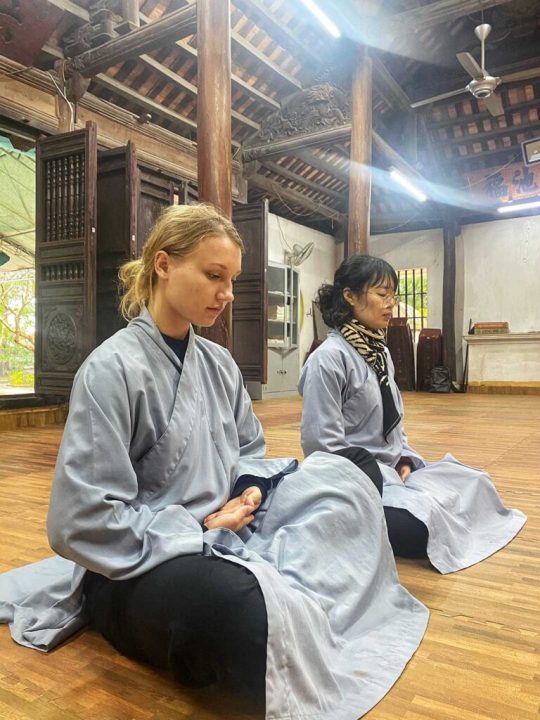
Overland to Ha Long Bay, which has been twice awarded the title of World Natural Heritage Site by UNESCO’s World Heritage Committee in 1994 and 2000. Upon arrival, we’ll check-in, enjoy a welcome drink, and receive a cruise briefing. Afterward, we’ll have lunch while cruising to explore the breathtaking Ha Long Bay, one of Vietnam’s most wondrous and scenic sights. Prepare to be amazed by the picturesque scenery, with over 3,000 limestone islets emerging magnificently from the clear and emerald waters. The bay is adorned with hundreds of peerless karst formations, beautiful grottoes, and caves.
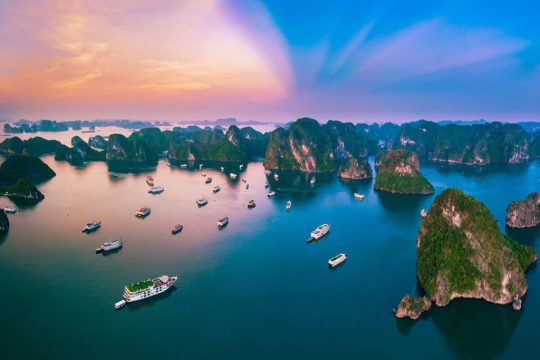
Wake up on the bay to the soothing sounds of waves and birds welcoming the new day. You will have the opportunity to witness the stunning sunrise over the bay while enjoying an invigorating Tai Chi session on the sundeck. After breakfast, we will visit a beautiful limestone grotto, followed by a leisurely walk back to the boat to capture a final glimpse of Halong Bay as we cruise back to the dock.

In the morning, embark on a boat journey to explore a captivating and untamed cave complex including Sang Cave, Toi Cave, Ba Giot Cave, and Nau Ruou. Witness the enchanting landscapes of mountains and rivers resembling Ha Long Bay in the picturesque region of Ninh Binh.
Afterwards, drive to Thanh Hoa to visit the Citadel of the Ho Dynasty, recognized as a world cultural heritage site in 2011. The citadel was built following the principles of feng shui and serves as a testimony to the flourishing of neo-Confucianism in late 14th-century Vietnam and its subsequent spread to other parts of East Asia. According to these principles, it was strategically situated in a landscape of exceptional scenic beauty, aligned with an axis that connects the Tuong Son and Don Son mountains, in the plain between the Ma and Buoi rivers. The citadel’s architecture represents an outstanding example of a new style of a Southeast Asian imperial city.
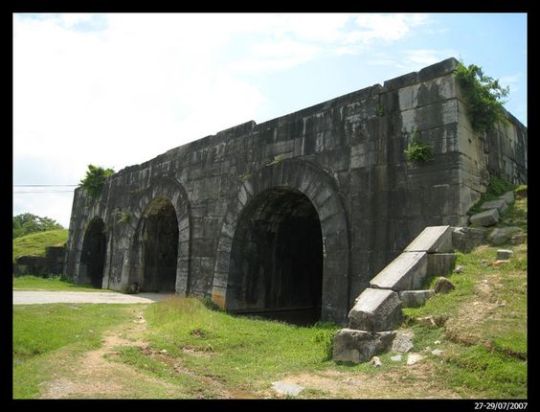

Driving to Hue, Vietnam’s last feudal capital, which has been recognized as a World Cultural Heritage Site since 1993. We will visit the Imperial Citadel, the Purple Forbidden City, and explore the bustling Dong Ba market.


After the breakfast, we will depart for Hoi An. This ancient town, with a history of 600 years, is an exceptionally well-preserved example of a traditional Asian trading port and has been recognized as a World Cultural Heritage Site since 1999. During our visit, we will explore its colorful pagodas, temples, ancient houses, narrow streets, and amazing bridges that showcase a unique architectural blend of Vietnamese, Chinese, and Japanese styles from the 16th century. In the late afternoon, we will take an excursion to Cam Chau village to witness the traditional lantern-making by the villagers. We will spend the night in Hoi An..
We are a team of experienced travel experts who have organized hundreds of buddhist spiritual retreat for customers from countries around the world. Our Online Customer Support team has many years of professional experience in the travel industry, and can assist with any questions related to your tour.
0 notes
Text
According to the Buddhist law of impermanence, everything changes and nothing lasts forever.
We began our day at Ho Quoc pagoda, Phu Quoc’s largest Buddhist temple, built in 2012 with an architectural style that can be traced back as far as the third century BC. The girls responded immediately to the sense of calm about the place, and they enjoyed peacefully exploring the various pagodas, taking in the many colours and smells, including red lanterns, golden dragons, jasmine and incense.

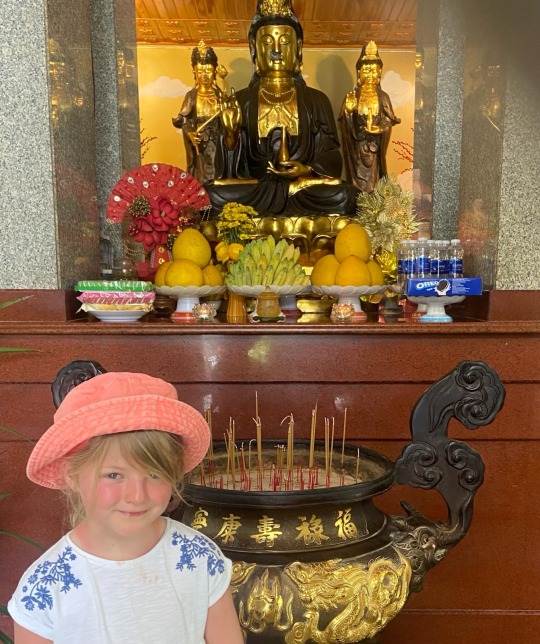

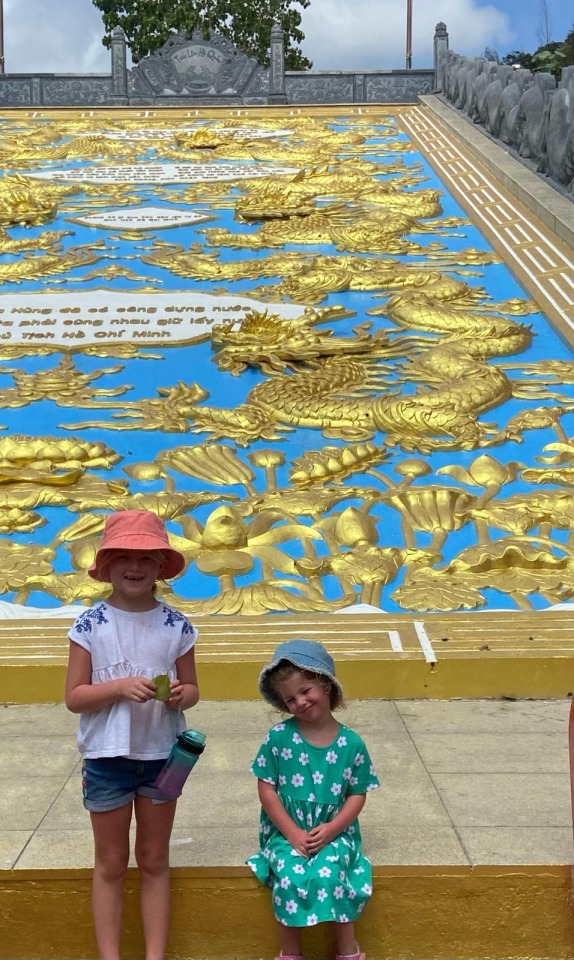
Among the site’s various statues - most of which depict Buddha in various forms - my eye was caught by a row of “Arhats”, who according to tradition were the original followers of Gautama Buddha. Having achieved the state of Nirvana by way of the four stages of enlightenment, they became free of worldly cravings and are now charged with protecting the Buddhist faith until the arrival of “Maitreya”, an enlightened Buddha prophesied to return to earth in the future.
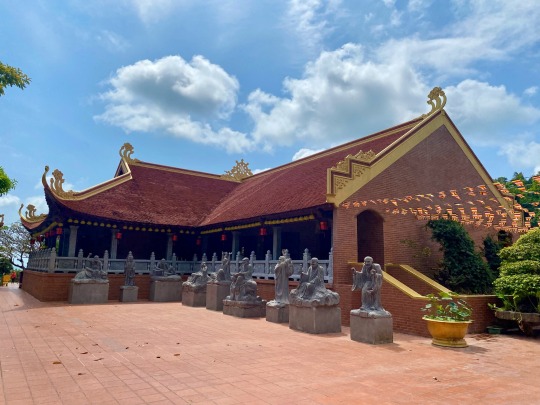
From Ho Quoc we headed to Sunset Town, a vast new development on the Southwestern corner of Phu Quoc which has been built up around the launch point of the world’s longest cable car to Hon Thom, a smaller island to the South of Phu Quoc which itself has seen rapid development in recent years with the construction of Aquatopia “Southeast Asia’s most modern water park”.
I had read about the scale and pace of Phu Quoc’s ambitious development in recent years, but it was still a shock to arrive at what is essentially a mock up of a Mediterranean town, complete with cobbled streets, pastel coloured townhouses, renaissance palaces and even its very own Colosseum!
The contrast with the temple was striking and I couldn’t help but wonder what the Arhats would make of all this. I’m sure there’s a clever insight to be made about French Indochina and Vietnam’s still recent fight for independence from European colonialism, but I can’t quite grasp it here so I’ll leave it alone.
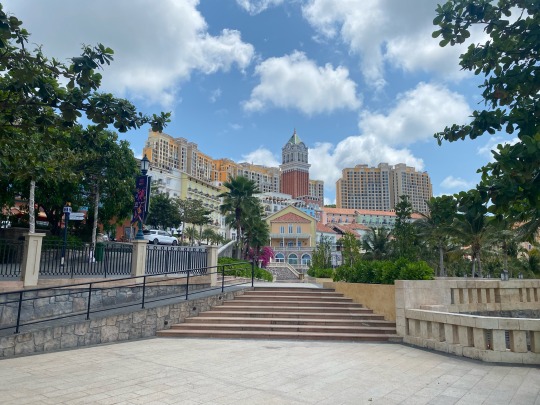
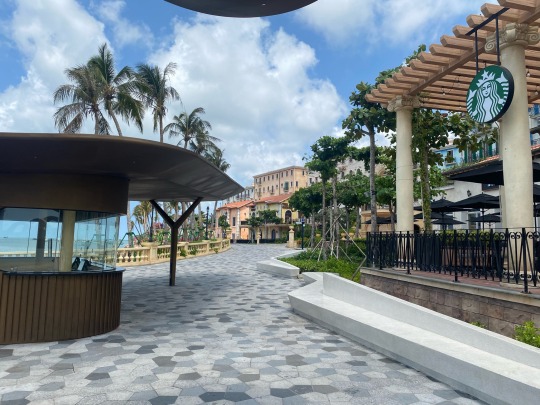
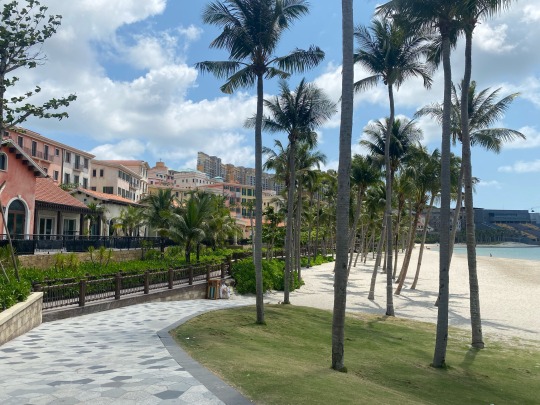

However, nothing could have prepared me for the most surprising feature of Sunset Town… the whole place was almost entirely empty. A mile of coastline, two white sand beaches, a state of the art bridge arcing out around the bay, rows and rows of units all carefully presented in the Mediterranean style, waiting to one day become the hotels, restaurants and shops of some future tourist utopia, but for now standing empty. The place felt eery, like a ghost town, only in reverse.
The story here is that when development happens at the scale and pace seen on Phu Quoc in recent years, things don’t always go to plan. A combination of rampant land speculation, development investment outpacing infrastructure investment, conflicting agendas between the local, national and international communities, serious issues with the management of plastic waste, and then Covid, have left many such developments across Phu Quoc standing empty. Their owners are most often big corporations such as the domestic giants Sun Group and Vin Group, whose pockets are deep enough to sit on their hands for now and bet on a future when these streets are filled with tourists from mainland Vietnam, China and beyond.
One thing is certain, change will continue to shape this land, as it does all lands, and everything in between. I am reminded today that to travel only offers a series of snapshots in time, slithers of experience to observe in context, and that’s enough.
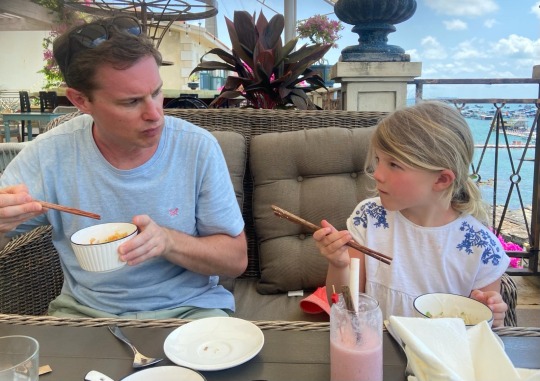
1 note
·
View note
Text
7 Days Trip to Vietnam from Delhi: A Guide to Planning Your Itinerary

Are you dreaming of an exotic getaway from Delhi? Look no further than the breathtaking landscapes and rich cultural tapestry of Vietnam. In this guide, we'll help you plan the perfect 7-day trip to Vietnam, covering the must-visit places and offering valuable insights to make your journey unforgettable.
Things to Do in Vietnam: A Sneak Peek

Vietnam is a treasure trove of experiences waiting to be explored. From bustling cities to serene landscapes, there's something for every traveler. Begin your journey in Hanoi, the vibrant capital, where ancient temples stand tall alongside modern skyscrapers. Don't miss the chance to take a leisurely stroll around Hoan Kiem Lake and immerse yourself in the local culture.
As you venture south, the charming town of Hoi An awaits with its well-preserved architecture and lantern-lit streets. Explore the ancient town, indulge in delicious local cuisine, and perhaps even try your hand at traditional lantern making.
For nature enthusiasts, the stunning landscapes of Ha Long Bay are a must-visit. Cruise through emerald waters surrounded by limestone karsts, creating a picture-perfect setting that will stay etched in your memory forever.
Honeymoon Destinations In Vietnam: Romantic Retreats

If you're planning a romantic escape, Vietnam has an array of enchanting spots tailor-made for Honeymoon Destinations In Vietnam. Picture this: a serene cruise in Ha Long Bay as the sun sets, casting a warm glow on the limestone cliffs. It's the perfect setting for a romantic evening with your special someone.
Escape to the idyllic beaches of Phu Quoc, where pristine white sands and turquoise waters create a haven for lovebirds. Take a leisurely stroll along the shore, indulge in a couples' spa retreat, or simply enjoy each other's company in this tropical paradise.
Hue, with its imperial citadel and poetic Perfume River, offers a romantic glimpse into Vietnam's history. Explore the ancient architecture hand in hand and witness the sunset from the iconic Thien Mu Pagoda.
Crafting Your 7-Day Itinerary
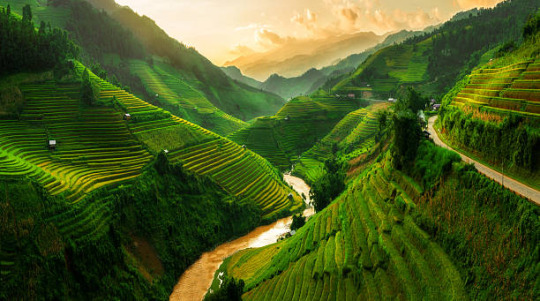
Now that we've piqued your interest with the incredible things to do in Vietnam and highlighted the romantic honeymoon destinations, let's dive into crafting your 7-day itinerary.
Day 1-2: Hanoi
Start your journey in Hanoi, exploring the Old Quarter, sampling local street food, and visiting historical landmarks such as the Ho Chi Minh Mausoleum and the Temple of Literature.
Day 3-4: Hoi An
Travel to Hoi An to experience its unique blend of history, architecture, and vibrant culture. Visit the Ancient Town, take a cooking class, and immerse yourself in the town's magical atmosphere.
Day 5-6: Ha Long Bay
Embark on a cruise in Ha Long Bay, marveling at the stunning karst formations. Enjoy activities like kayaking and cave exploration, and savor the tranquility of this UNESCO World Heritage Site.
Day 7: Phu Quoc
Conclude your trip in the romantic setting of Phu Quoc. Relax on the beaches, explore the night markets, and create lasting memories in this tropical paradise.
Final Tips for Your Vietnam Adventure

Pack comfortable clothing suitable for both city exploration and beach relaxation.
Embrace the local cuisine; Vietnamese street food is a culinary adventure in itself.
Respect local customs and traditions, and engage with the friendly locals to enhance your experience.
In conclusion, a 7-day trip to Vietnam from Delhi promises a perfect blend of cultural exploration and romantic retreats. Whether you're seeking adventure, relaxation, or a bit of both, Vietnam has it all. So, pack your bags, embark on this unforgettable journey, and create memories that will last a lifetime.
#Honeymoon Destinations In Vietnam#Destinations In Vietnam#Things To Do In Vietnam#7 Days Trip to Vietnam from Delhi#Trip to Vietnam from Delhi
0 notes
Text
Hanoi Night Tour Best Tours to Explore the Capital City's Nightlife
Join us after dark as the city lights up for these 6 Hanoi night tour. A vibrant evening of local food and laughter, or a peaceful night in the city's cultural center is up to you.
If you are in the capital city and interested in exploring the place's enchanting nightlife, these are the 6 best Hanoi night tours to consider. Experience unique activities that are only available after sundown, and let these unforgettable trips reveal different facets of the city.
Hanoi Night Tour #1: Giải Mã Hoàng Thành Thăng Long
Built in the 11th century, Thăng Long Imperial Citadel symbolized the independence of the Đại Việt (Great Việt) nation. For nearly 13 consecutive centuries, this area was the political epicenter of the country, witness of countless significant historical events. Today, it is a still-standing representation of a distinct Southeast Asian civilization particular to the lower Red River Delta. The structures and their remnants were listed among the UNESCO World Heritage in August 2010, and are now located at the 18 Hoang Dieu archaeological site.

Decoding The Imperial Citadel Of Thang Long Night Tour
The Hanoi night tour, named Decoding the Imperial Citadel of Thăng Long, is available every weekend at 7 PM. The 1.5-hour tour begins at Đoan Môn (Main Gate), the entrance of Cấm Thành (Forbidden City), or the king’s residence. Through the tour guide, visitors learn about the history, architecture, and uses of the area.
Upon arrival at the archaeological excavation site, a welcoming traditional dance is presented on the glass covering the area. Visitors are then given a tour of the dig, which contains artifacts from the Ly, Tran and Le dynasties. A trip to an exhibition hall with rare relics, some over a thousand years old, is also included.
The Hanoi night tour ends with a laser light show showcasing Thăng Long Imperial Citadel's most notable artifacts. There is also a minigame in which visitors must identify common items from feudal dynasties in the past.
Hanoi Night Tour #2: Double-decker Bus Night Tour
The double-decker bus tour, departing daily from 8 AM to 8.30 PM, is an unforgettable experience for any tourist visiting the capital city. The open-air, 80-seat double-decker buses make 12-15 stops and visit around over 20 iconic landmarks in only an hour. Due to the walking street nearby, there will be 2 alternative weekday and weekend departure points and routes. The bus will typically stop at these following attractions, allowing travelers to explore and experience the city in their leisure:
Dong Kinh Nghia Thuc Square – Hoàn Kiếm Lake (Mon - Fri)
Hanoi Opera House – (Sat - Sun)
Le Thai To’s Statue
St. Joseph’s Cathedral
The Flag Tower of Hanoi
Ho Chi Minh Mausoleum
Quan Thanh Temple
Tran Quoc Pagoda
Cua Bac Church
The Imperial Citadel of Thang Long
One Pillar Pagoda
The Temple of Literature
Hoa Lo Prison Relic
Museum of Vietnamese Women
Hanoi Opera House
Hanoi Post Office
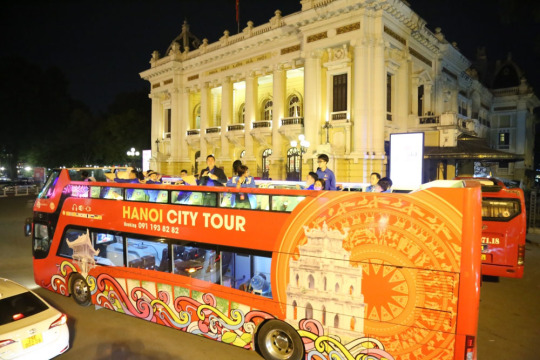
Bus Night Tour Hanoi
The bus has accessible seating for the young, old, and physically disabled. An itinerary map, multi-languages audio guides & headsets are available for tourists to learn more of the attractions. If interested, one can choose whether or not to get off the ride and explore the site on their own. The bus is also equipped with free wifi, air conditioning and a guide staff for a more comfortable ride.
Tickets are available for purchase at Dong Kinh Nghia Thuc Square, 7 Dinh Tien Hoang Street, or at a kiosk on 51 Ly Thai To Street.
Hanoi Night Tour #3: Inbound Vietnam's Food Tour At Night
Finding your way around Hanoi's crowded streets might be difficult on your own, especially when there's a lot of different Vietnamese culinary options to try. Here at Inbound Vietnam, visitors need only follow our insider's guide to some of Hanoi's finest food stands and eateries.
For our Hanoi night tour, you can choose your hotel's departure time along with the foods you wish to avoid. A foodie as your guide guarantees you can experience all of the delicacies that make Hanoi a top culinary destination. And while filling up on the best street food the capital has to offer, you can take in the locals' and the city's nightlife.
https://v2.inboundvietnam.com//Web/Resources/Uploaded/1/images/News/TravelGuide/Hanoi-Street-Food-Tour.jpg
Hanoi Food Tour At Night with Inbound Vietnam
The Old Quarter, with its small lanes and antique brick homes, is the heart of our night food tour. The area is a maze of narrow streets that were once a hub for merchants and artisans. Many take their names from the commodities that were traded there, like Hang Go (Wood Product), Hang Ga (Chicken), Hang Chao (Porridge), to name a few.
There is an active effort from the area to accommodate Hanoi's dynamic atmosphere, while still holding on to its unique and nostalgic way of life. There are no skyscrapers or upscale shops; instead, the streets are a bit smaller so expect occasional traffic. At the end of our Hanoi night tour, you are free to explore the area on your own. So take your time, and enjoy the modest but no less vibrant and bustling nightlife.
Hanoi Night Tour #4: Hoa Lo Prison Relic
The historical site Hoa Lo Prison, also known among locals as "Hell on Earth", is a more thrilling destination to visit. This Hanoi night tour will expose visitors to the cruelty of the French colonial prison during their warfare with Vietnam. Though construction barely finished in 1899, tens of thousands of Vietnamese revolutionary soldiers and activists had been imprisoned since. Under inhumane conditions and tortures, not many had made it out alive.

Hoa Lo Prison which brings you closer to the experiences of its prisoners than ever before.
Travel back in time for 80 minutes as visitors witness the colonial prison's brutality and the honorable sacrifice of national heroes during the Indochina wars. There is also a unique spiritual area built after the war for locals to honor their predecessors. Although Hoa Lo is open for daytime tours, the night visits offer a truly unique experience. Light and sound effects are used to stimulate an eerie night atmosphere in the relic area, promising to evoke the audience’s emotions and senses.
The Hoa Lo Prison night tours open from 7 PM every Friday, Saturday and Sunday at 1 Hoa Lo Street. Due to high demand, travelers should reserve tickets 3-4 days in advance to avoid missing out on this unique experience.
Hanoi Night Tour #5: Vietnam Literature Museum
This one-of-a-kind Hanoi night tour brings visitors back to the golden age of Vietnamese literature. The 90-minute visit takes place in the Vietnam Literature Museum, a 3,000-square-meter space displaying over 3,454 artifacts from generations of renowned Vietnamese authors and cultural figures.
The tour begins with a visit to the gardens of 20 influential figures in Vietnamese literature. Then, visitors can carry the Tam (Soul) and Tai (Talent) symbols written on a traditional lantern to move to the Temple of Vietnamese Literature, also known as the ancient and medieval Vietnamese literary venue. The tour guide will show the preserved ancient bibliographies, the two "Declarations of Independence" from past dynasties, and discuss the use of Vietnamese's Nom and Chinese characters in literature. The temple also features a section dedicated to the great poet Nguyen Du and his 'Kieu story', as well as a poetry reading activity.

Hà Nội's first ever literature tour launched
The literary tour will then lead visitors to the Critical Realism Literature space on the second floor of the museum. There will be a short theater scene from the story 'Chi Pheo' and an area dedicated to President Ho Chi Minh and his poetry. Tourists can also learn about Vietnam's most prominent writers and their best-known works, such as children's novelist To Hoai's 'Diary of a Cricket', or poet-playwright Luu Quang Vu and poet Xuan Quynh.
Visitors can choose to finish the tour with a number of activities, from crossword puzzles, calligraphy, to tea ceremony. This Hanoi night tour is designed not only for those who are interested in Vietnamese literature, but also for people of all ages to deepen their understanding of literature.
The Vietnam Literature Museum is located at 275 Au Co Street, Tay Ho District. The tour opens every Saturday and Sunday, and entry price for adults is currently 150,000 VND (6.3 USD).
Hanoi Night Tour #6: Dao Ngoc - Ngu Xa Food and Pedestrian Zone
Dao Ngoc - Ngu Xa, an islet on Truc Bach Lake in the Ba Dinh District, is Hanoi's latest nighttime food and pedestrian zone. The zone encompasses two streets, Ngu Xa and Nguyen Khac Hieu, traversing the center of the 4.5ha Dao Ngoc islet.

Dao Ngoc Ngu Xa night food street in Hanoi
The area was already well-known among locals for its existing restaurants and the Pho spring roll dish. Travelers can expect new eateries, beverage shops and market activities from the Ngu Xa community. There will also be cultural events on the weekend, so get ready for a new culinary and cultural destination in the district.
Dao Ngoc - Ngu Xa will be open on Friday (6 - 10 PM), Saturday and Sunday (7 AM - 10 PM). Similar to the walking street at Hoan Kiem lake, the zone will be closed to vehicles to serve pedestrians only.
1 note
·
View note
Photo

helloooo.....still on the island “phu quoc”
#phu quoc#vacation#ole#asia#vietnam#island#buddhist#Thiền viện Trúc Lâm Hộ Quốc#Trúc Lâm Hộ Quốc Zen Monastery#Ho Quoc Pagoda
1 note
·
View note